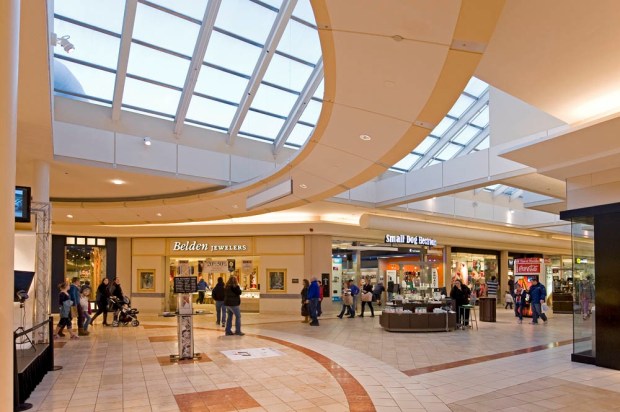The Evolving Anchor Stores

The fate of the malls of America has been a favored topic of discussion in recent years, particularly as the fortunes of malls and their operators have come to look increasingly tenuous. This has been particularly clear in 2016 as anchor stores, like Macy’s and Sears, have stumbled and announced mass closures. And the smaller “mall brands” that exist alongside them in America’s various shopping enclosures have seen their bottom lines eaten alive. Aéropostale and PacSun went bankrupt, and Gap and J.Crew are both looking ever less likely to get their long-promised “comebacks” out of first gear.
It’s been eventful, but not all that surprising — or, at least, not to our long-term readers. A little under two years ago, while watching the holiday shopping season increasingly unfold online, Karen Webster had a not-so-holly-jolly prediction. What looked like a slowdown then was the early phases of the physical retail death spiral warming up.
“If you are a store in a mall, it’s even worse since malls aren’t exactly the healthiest of retail artifacts these days to begin with. We haven’t seen a new shopping mall open in the U.S. since 2006, and vacancy rates at the ones that exist are at their highest levels since 1991, according to industry analysts. Anchor stores in a mall, like a Macy’s or JCP, bear pretty high fixed costs. And long-term leases were negotiated when online was an infant and mobile was an embryo … The smaller stores that line the perimeter of those malls are there for one and only one reason: to benefit from the foot traffic from shoppers on their way to those anchor stores. But if time-crunched and budget-conscious shoppers are in and out of the mall, on their own missions and visiting fewer stores while shopping online in between, that’s not happening.”
So, malls — particularly, working and middle-class malls in the Midwest — are seeing anchor stores closing in waves. Macy’s alone is closing 100 between now and early 2017. JCPenney and Sears — two other popular mall brands — also have closures planned for 2016–2017, as does Kohl’s, though none on quite as grand a scale as Macy’s.
Yet.
And that was the operating fear as summer closed out in 2016: Macy’s is the start of the great selloff trend in anchor stores and, with that trend, would come a swift merciless death to many of the nation’s remaining malls. The physical retail death spiral — at the mall anyway — looks to be both speeding up and getting ever closer to hitting the ground.
Yet, not all worries are created equally — or distributed equally either for that matter, which means it may come as some surprise that those one might suspect would be naturally most concerned about the drastic downsizing of mall anchor stores are actually the least worried and the most ready to reimagine the mall.
Mall Operators Are Wondering If They Really Need ‘Anchor’ Stores At All
Given that there is a Macy’s in 70 percent of the malls that General Growth Properties (GGP) operates, one might assume the announcement that Macy’s is rolling up shop on 14 percent of its physical stores nationwide would be taken as something of a crushing bummer. But if GGP is bummed out in the least, it sure isn’t letting on publicly.
In fact, it’s working with Macy’s to let it know which mall it would be especially excited to let it out of its leases on.
Because, according to GGP, the department store model doesn’t really drive traffic anymore. There are smaller “secondary” stores that do it better, and with no new malls being built in the U.S., the large spaces that anchor stores take up can be redeveloped into all kinds of other things that actually do bring people to the mall. Upscale restaurants, fitness centers, child play zones, entertainment venues or even just different types of retailers, like grocery stores or outlet stores — all drive more footfall and pay much more rent than the anchor clients of the past did.
Retrofitting is expensive. GGP estimates that it’s spent over a billion dollars since 2011 redeveloping 80 department stores nationwide, but it is an effort that has paid off and the mall operator believes will continue doing so.
A Sector Not Exactly Broken Up
And while a mall operator puts the best possible outlook on losing anchor stores as a mainstay of its business, it is notable at least how many firms that one might have been expected to be a bit more broken-up about the scale-back of the anchor store model are pretty sanguine about.
Gap CEO Arthur Peck noted that Macy’s wasn’t helping Gap bring in all that much traffic, but Macy’s getting gone from a lot of the malls they still share will make operations rather easier for Gap (and its various brands), since Gap’s brands have good co-tenancy clauses. When a traffic-generating anchor store closes in a center where it operates, its operating costs go down because rents fall accordingly.
Plus, Macy’s gone and replaced by a steakhouse is one less apparel dealer in the center.
“That is demand that is going to get placed into other businesses,” Peck said.
PVH Chief Executive Manny Chirico (PVH is behind Calvin Klein and Tommy Hilfiger — both Macy’s-stocked brands) noted that, since its materials are only stocked in a limited way across the chain in high-performing stores, its exposure to Macy’s contraction is relatively limited.
“It’s not that big [of] an issue for us.”
And perhaps, it will not turn out to be that big an issue for anyone. Malls won’t be the same. The era of the anchor store seems well around the death spiral, but the mall reinvented as commerce experience centers.
Well, there might be more to that, and we’ll tell you all about it in future reports.
